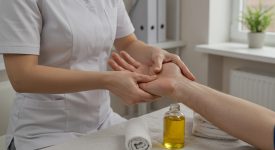
5 Powerful Hand Massage Techniques to Loosen Dupuytren’s Tissue Naturally
Introduction
Hand Massage has long been used to relieve stiffness and promote circulation in tight tissues. For Dupuytren’s patients, gentle manual therapy can complement medical treatments by keeping the hand supple and supporting recovery after injection or surgery. When done carefully, it may ease tension and reduce scar adhesions without stimulating new fibrosis.
How Hand Massage Supports Healing
Dupuytren’s disease is driven by an overactivation of fibroblasts—cells that produce excess collagen and form the thick, fibrous cords beneath the skin. These cords gradually pull the fingers inward, limiting movement and causing discomfort. While massage cannot dissolve these cords, it can play an important supportive role in maintaining hand health. Gentle, consistent massage encourages better micro-circulation and lymphatic flow, helping clear away metabolic waste and toxins that contribute to inflammation. It also promotes tissue elasticity, keeping the surrounding fascia and tendons supple so that everyday hand movements remain easier and less painful. When integrated with physical therapy or stretching exercises, massage becomes a valuable complementary approach to overall hand rehabilitation. (External link: NIH Complementary Therapies)
Best Techniques for Dupuytren’s
- Myofascial release: Slow, light pressure to lengthen tissue around nodules.
- Cross-fiber massage: Gentle side-to-side motion over cords to increase elasticity.
- Circular massage: Improves blood flow to the palm and fingers.
- Stretch integration: Follow massage with finger extension exercises.
(Internal link: Physical Therapy for Dupuytren’s: Can Exercise Improve Outcomes)
When and How Often
Hand Massage should never be performed on an inflamed or fresh post-operative wound. Once healed, most therapists recommend 5–10 minutes of gentle work twice daily using a neutral oil like coconut or castor oil to reduce friction. Moderate pressure is key—too deep can aggravate fibroblasts and cause flare-ups.
Scientific Findings
A 2020 study in Complementary Therapies in Medicine reported that manual therapy improved hand mobility and pain scores in fibrotic conditions similar to Dupuytren’s. Improved blood flow and tissue oxygenation were observed after consistent sessions. (PMC Study Link)
Combining Hand Massage with Therapy
Hand massage works best as part of a broader rehabilitation program that includes stretching, splinting, and nutrition for tissue repair. Patients often combine self-massage with professional sessions during the first three months post-treatment. (Internal link: Inflammation and Dupuytren’s: The Hidden Driver)
Cautions
- Avoid pressing directly on painful nodules.
- Do not massage areas with redness or heat.
- Stop if pain or swelling increases.
- Consult a hand specialist before starting if recent surgery or injection was performed.
(External link: Mayo Clinic Dupuytren’s Care Guidelines)
What Dupuytren’s Patients Should Know
Massage cannot dissolve cords or reverse contractures, but it can slow tightening and enhance comfort. Paired with therapeutic stretching and anti-inflammatory habits, it supports circulation and keeps the hand more functional between medical treatments.






